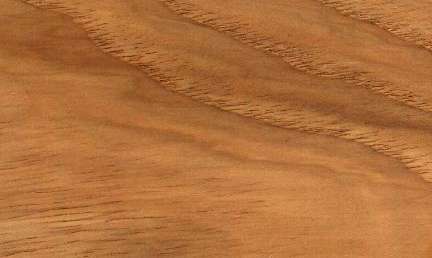
Shellbark hickory (Carya lacinosa)
Family: Juglandaceae
Common names: Big shagbark hickory, Hickory, Kingnut, Shellbark hickory
Distributed in: Canada, United States (North America)
Distribution overview: In North America, this species grows in southeastern Canada and eastern United States. It occurs from southeast Iowa east to Ohio and southwest Pennsylvania, south to Tennessee and west to northeastern Oklahoma. It is also found in localized areas in southern Ontario in Canada, and New York, northern Georgia, and Mississippi in the United States.
Common uses: Baseball bats, Charcoal, Drum sticks, Fishing rods , Flooring, Fuelwood, Skis, Sporting Goods, Textile equipment, Tool handles, Vehicle parts
Environment profile: Status has not been officially assessed
Tree size: Trunk diameter is 100-150 cm
Colors: the heart isBrown, Reddish brownand the sapwoodWhite, Yellow.The grain isWavy, the textureFine
Natural durability: Susceptible to insect attack, Very little natural resistance
Odor: No specific smell or taste
Kiln Schedules: White handles
Kiln Drying Rate: Naturally dries slowly
Drying Defects: Severe shrinkage may result, Slight twist/warp
Ease of Drying: Slowly
Blunting Effect: Severe effect
Boring: Excellent (95+ pieces out of 100 will yield excellent results)
Cutting Resistance: Satisfactory sawing properties
Gluing: Difficult to glue
Mortising: good
Moulding: Fair to Good
Movement in Service: Fair to Good
Nailing: Pre-boring recommended, Very Good to Excellent
Planing: Very Good to Excellent
Resistance to Impregnation: Wood moderately responsive to treatment
Response to hand tools: Easy to Work
Veneering qualities: Veneers easily, Veneers moderately easy
Steam bending: Excellent
High bending and crushing strengths, high stiffness and high resistance to shock loads make hickory extremely suitable for steam bending applications
Turning: Good results
Polishing: Polishing characteristics are good to very good
; Staining: Stains well
;
- Numerical data Metric
- Numerical data English
- Strength properties
- References
 |
 |
 |
 |
| Item |
Green |
Dry |
Metric |
| Specific Gravity |
0,58 |
0,63 |
|
| Density |
|
673 |
kg/m3 |
| Bending Strength |
723 |
1247 |
kg/cm2 |
| Crushing Strength |
55 |
124 |
kg/cm2 |
| Hardness |
|
|
kg |
| Impact Strength |
258 |
218 |
cm |
| Shearing Strength |
|
145 |
kg/cm2 |
| Stiffness |
92 |
130 |
1000 kg/cm2 |
| Tangential Shrinkage |
13 |
|
% |
| Radial Shrinkage |
8 |
|
% |
| Weight |
|
|
kg/m3 |
| Maximum Load |
1,68 |
2,03 |
cm-kg/cm3 |
| Toughness |
|
|
cm-kg |
| Static Bending |
|
|
kg/cm2 |
|
 |  |  |  | | Item | Green | Dry | English | | Bending Strength | 10290 | 17738 | psi | | Crushing Strength | 794 | 1764 | psi | | Density | | 42 | lbs/ft3 | | Impact Strength | 102 | 86 | inches | | Maximum Crushing Strength | 3842 | 7840 | psi | | Shearing Strength | | 2068 | psi | | Stiffness | 1313 | 1852 | 1000 psi | | Work to Maximum Load | 24 | 29 | inch-lbs/in3 | | Specific Gravity | 0.58 | 0.63 | | | Radial Shrinkage | 8 | | % | | Tangential Shrinkage | 13 | | % | | Volumetric Shrinkage | 19 | | % | |
Several species of Carya, including Shellbark (C. laciniosa ), Pignut (C. glabra ), Mockernut (C. tomentosa ), and Shagbark (C. ovata ) are usually marketed together as hickory because of very close similarities. Density and other related properties of the species are significantly determined by the rate of growth. Wood with wide growth rings is generally high in density and strength. The wood has very good strength properties in relation to its weight, and is well suited for applications where shock resistance is required. Strength properties are slightly superior to those of European beech (Fagus ), but toughness is considerably higher
Boone, R.S., C.J. Kozlik, P.J. Bois and E.M. Wengert. 1988. Dry Kiln Schedules for Commercial Woods: Temperate and Tropical. United States Department of Agriculture, Forest Service, General Technical Report FPL-GTR-57, Forest Products Laboratory, Madison, Wisconsin.HMSO. 1981. Handbook of Hardwoods, 2nd Edition. Revised by R.H. Farmer. Department of the Environment, Building Research Establishment, Princes Risborough Laboratory, Princes Risborough, Aylesbury, Buckinghamshire.Lincoln, W.A. 1986. World Woods in Color. Linden Publishing Co. Inc. Fresno, California.Rendle, B.J. Editor. 1969. World Timbers, Volume Two - North & South America (Including Central America and the West Indies). Published by Ernest Benn Limited, Bouverie House, Fleet Street, London.USDA. 1987. Wood Handbook - Wood as an Engineering Material. United States Department of Agriculture (USDA, Forest Service, Agriculture Handbook No. 72, Forest Products Laboratory, Madison, Wisconsin.
|








